Phandelver Probabilities
Let's use the Python programming language to explore some of the dice roll probabilities in a D&D 5e adventure. I personally find math easier to understand when it's expressed as Python code and I want to improve my familiarity with plotting (graphing) using the matplotlib Python library.
Setup
D&D Specifics
We'll be looking at the first encounter of the Lost Mine of Phandelver adventure using the pregenerated characters (see Notes and References, below).
Python Imports and Globals
First we'll load the Python imports and globals:
# Standard library from itertools import product from statistics import fmean # Third-party import matplotlib.pyplot as plot import matplotlib.ticker as ticker import numpy %matplotlib inline plot.style.use("ggplot")
Probability
The basic formula for probability is the frequency (identified outcomes) divided by the total possible outcomes. For example
frequency = 1 # any given number on a d20 occurs once total_possible_outcomes = 20 # there are 20 sides print( "Rolling any given number on a d20 has a probability of:" f" {frequency}/{total_possible_outcomes} or" f" {int(frequency / total_possible_outcomes * 100)}%" )
Rolling any given number on a d20 has a probability of: 1/20 or 5%
Dice Numpy Arrays
We can use the numpy library to make things easier for ourselves. Its array objects work very nicely with plotting and we can quickly generate the range of numbers used by dice using its functions:
def dice(formula): """ Create numpy array from dice formula (example: 3d6 + 2) """ modifier = 0 count, faces = formula.split("d") if not count: count = 1 else: count = int(count.strip()) if "+" in faces: faces, modifier = faces.split("+") modifier = int(modifier.strip()) elif "-" in faces: faces, modifier = faces.split("-") modifier = int(f"-{modifier.strip()}") faces = int(faces.strip()) array = numpy.arange( (1 * count) + modifier, (faces * count) + modifier + 1 ) return array d4 = dice("d4") d6 = dice("d6") d8 = dice("d8") d12 = dice("d12") d20 = dice("d20")
Simple Plot
The probability plot of a single dice roll is fairly boring:
# d20 is defined above # Determine frequency of each number (will return an array contain twenty 1s) frequency = numpy.unique(d20, return_counts=True)[1] # Create probability array for rolling each number probability = (frequency / len(d20)) * 100 # Initialize plot fig, ax = plot.subplots() fig.set_size_inches(8, 1) # Create bar plot for result probability of a normal d20 roll ax.bar(d20, probability) # Configure Title ax.set_title("Probability of rolling each number on a d20") # Confgure X Axis ax.set_xlabel("Die result") ax.xaxis.set_major_locator(ticker.FixedLocator(d20)) # Configure Y Axis ax.set_ylabel("Probability") ax.yaxis.set_major_formatter(ticker.PercentFormatter()) ax.yaxis.set_minor_locator(ticker.AutoMinorLocator()) ax.set_ylim(0, 7)

Ability Checks
It's a little more interesting, however, if we plot the chance of exceeding a number when rolling a d20. In D&D 5e the number that must be matched or exceeded is the Difficulty Class (DC). It's also worth noting that Armor Class (AC) is simply a specific type of DC. More interesting still are the probability plots for rolls with advantage and disadvantage:
# d20 is defined above def annotate(ax, index, probability, color="white"): """ Annotate top of bar plot with exact probability percentage """ if probability >= 100.0: text = f"{probability:0.0f}%" else: text = f"{probability:0.2f}%" ax.annotate( text, (index, probability - 0.5), color=color, fontsize="xx-small", fontweight="bold", horizontalalignment="center", verticalalignment="top", zorder=5, ) # Create probability array for rolling DC or higher with advantage advantage_roll = ((len(d20) ** 2 - (d20 - 1) ** 2) / len(d20) ** 2) * 100 # Create probability array for rolling DC or higher on a d20 normal_roll = ((len(d20) - (d20 - 1)) / len(d20)) * 100 # Create probability array for rolling DC or higher with disadvantage disadvantage_roll = (((len(d20) - (d20 - 1)) ** 2) / len(d20) ** 2) * 100 # Initialize plot fig, axs = plot.subplots(3, 1) (ax1, ax2, ax3) = axs fig.set_size_inches(14, 12) # Create bar plot and annotation for success probability with advantage ax1.bar(d20, advantage_roll + 5, bottom=-5, color="C2", label="with advantage") for i, probability in enumerate(advantage_roll): annotate(ax1, d20[i], probability) # Create bar plot and annotation for success probability of a normal d20 roll ax2.bar(d20, normal_roll + 5, bottom=-5, color="C6", label="normal d20 roll") for i, probability in enumerate(normal_roll): annotate(ax2, d20[i], probability, "black") # Create bar plot and annotation for success probability with disadvantage ax3.bar( d20, disadvantage_roll + 5, bottom=-5, color="C1", label="with disadvantage", ) for i, probability in enumerate(disadvantage_roll): annotate(ax3, d20[i], probability) # Configure Title ax1.set_title("Probability of rolling DC or higher") # Confgure X Axis for ax in axs: ax.xaxis.set_major_locator(ticker.FixedLocator(d20)) ax3.set_xlabel("DC (Difficulty Class)") # Configure Y Axis ax2.set_ylabel("Probability") for ax in axs: ax.yaxis.set_major_formatter(ticker.PercentFormatter()) # Configure Legend for each axis for ax in axs: ax.legend()
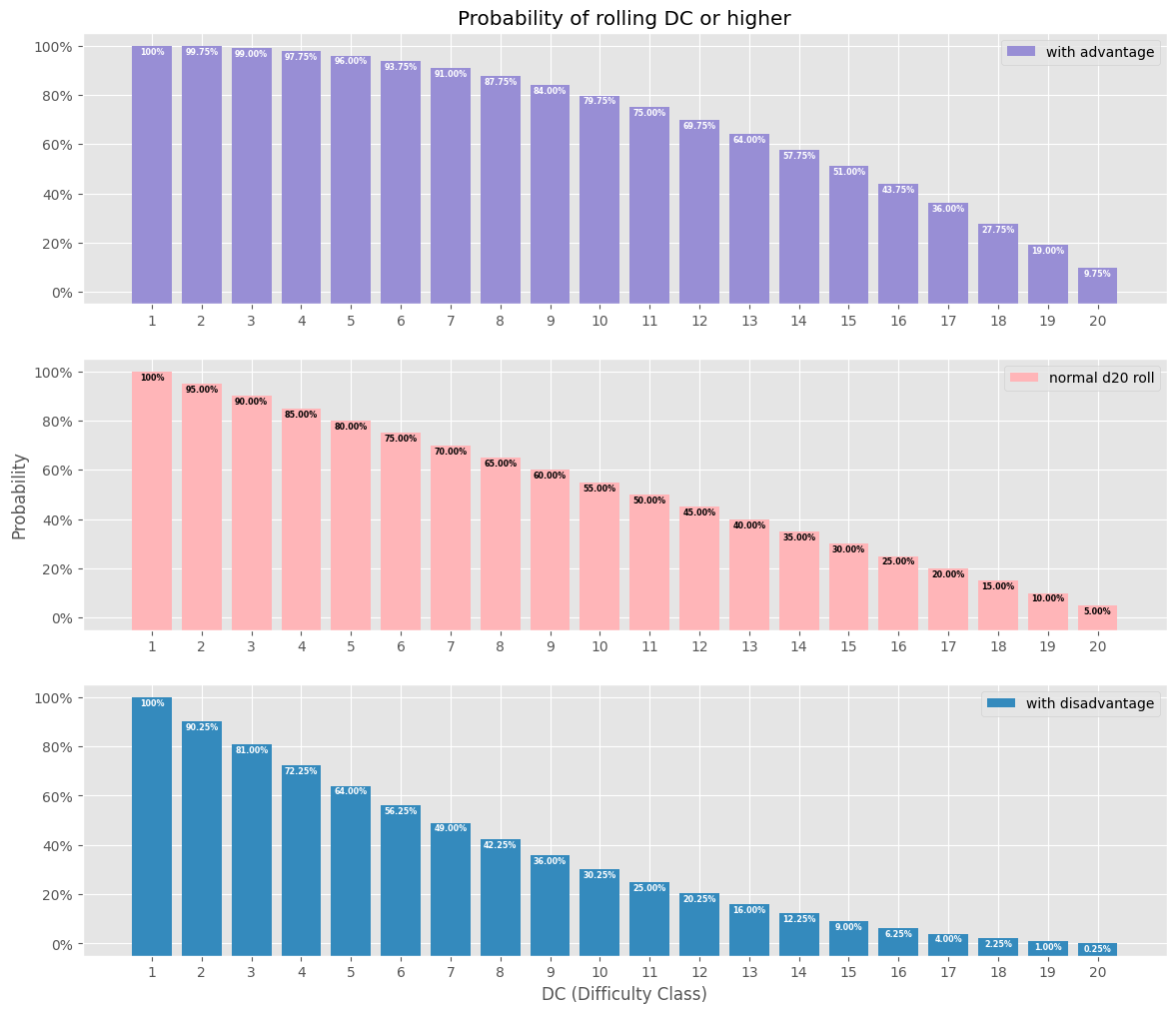
Or all together:
# annotate(), d20, advantage_roll, normal_roll, and disadvantage_roll are defined above # Initialize plot fig, ax = plot.subplots() fig.set_size_inches(14, 8) # Create bar plot for success probability with advantage ax.bar( d20, advantage_roll + 5, bottom=-5, width=0.9, color="C2", label="with advantage", ) for i, probability in enumerate(advantage_roll): annotate(ax, d20[i], probability) # Create bar plot for success probability of a normal d20 roll ax.bar( d20, normal_roll + 5, bottom=-5, width=0.8, color="C6", label="normal d20 roll", ) for i, probability in enumerate(normal_roll): annotate(ax, d20[i], probability, "black") # Create bar plot for success probability with disadvantage ax.bar( d20, disadvantage_roll + 5, bottom=-5, width=0.7, color="C1", label="with disadvantage", ) for i, probability in enumerate(disadvantage_roll): annotate(ax, d20[i], probability) # Configure Title ax.set_title("Probability of rolling DC or higher") # Confgure X Axis ax.set_xlabel("DC (Difficulty Class)") ax.xaxis.set_major_locator(ticker.FixedLocator(d20)) # Configure Y Axis ax.set_ylabel("Probability") ax.yaxis.set_major_formatter(ticker.PercentFormatter()) ax.yaxis.set_major_locator(ticker.MultipleLocator(10)) # Configure Legend ax.legend()
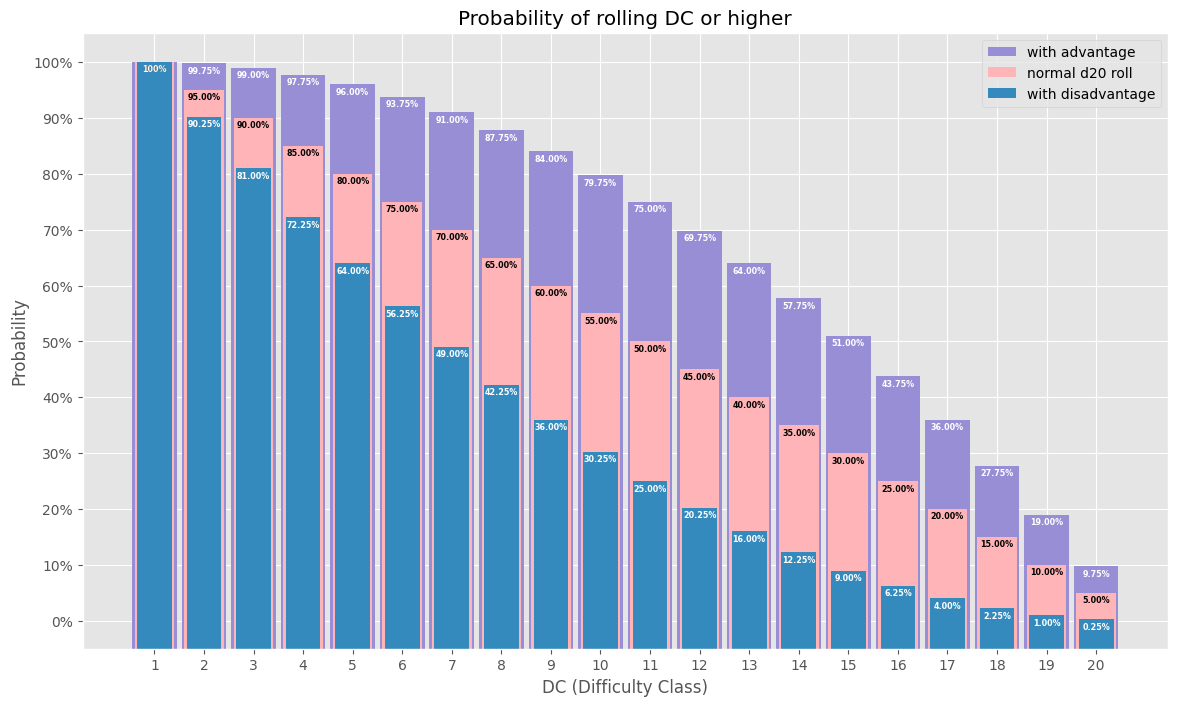
Goblin Ambush
Four goblins attempt to ambush the party. Their stealth modifier is +6 vs the party's passive perception. Will they surprise everyone in the party?
# annotate(), d20, and normal_roll are defined above def get_success_chance(dc, modifier): """ Determine probibility of success for a given DC with a modifier d20 roll. """ # Create probability array for rolling DC or higher on a d20 keys = d20 + modifier if keys[0] > dc: chance = 100 elif keys[-1] < dc: chance = 0 index = keys.tolist().index(dc) return normal_roll[index] goblin_stealth_modifier = 6 player_names = [ "Dwarven Cleric\n13 passive perception", "Elf Wizard\n13 passive perception", "Halfling Rogue\n10 passive perception", "Human Fighter 1\n13 passive perception", "Human Fighter 2\n13 passive perception", ] players_passive_perception = [13, 13, 10, 13, 13] players_observation_chance = [] for i, passive_perception in enumerate(players_passive_perception): observation_chance = 100 - get_success_chance( passive_perception, goblin_stealth_modifier ) players_observation_chance.append(observation_chance) party_observation_chance = fmean(players_observation_chance) # Initialize plot fig, axs = plot.subplots(1, 2, width_ratios=[5, 1]) (ax1, ax2) = axs fig.set_size_inches(8, 4) # Create bar plot and annotation for observation probability of each player for i, observation_chance in enumerate(players_observation_chance): if i < 4: color = f"C{i}" else: color = "C5" ax1.bar(i, observation_chance, color=color) annotate(ax1, i, observation_chance) # Create bar plot and annotation for observation probability of entire party ax2.bar(0, party_observation_chance, color="C4") annotate(ax2, 0, party_observation_chance, "black") # Configure Title ax1.set_title("Probability of observing the sneaking goblins") # Confgure X Axis ax1.xaxis.set_major_locator(ticker.FixedLocator(range(len(player_names) + 1))) ax1.xaxis.set_major_formatter(ticker.FixedFormatter(player_names)) ax1.xaxis.set_tick_params(labelrotation=45, labelsize="small") ax2.xaxis.set_major_locator(ticker.FixedLocator([0])) ax2.xaxis.set_major_formatter(ticker.FixedFormatter(["Entire Party"])) ax2.xaxis.set_tick_params(labelrotation=45, labelsize="medium") # Configure Y Axis ax1.set_ylabel("Probability") ax1.yaxis.set_major_formatter(ticker.PercentFormatter()) ax2.yaxis.set_major_formatter(ticker.PercentFormatter()) ax2.set_ylim(ax1.get_ylim()) # use same scale for both axes
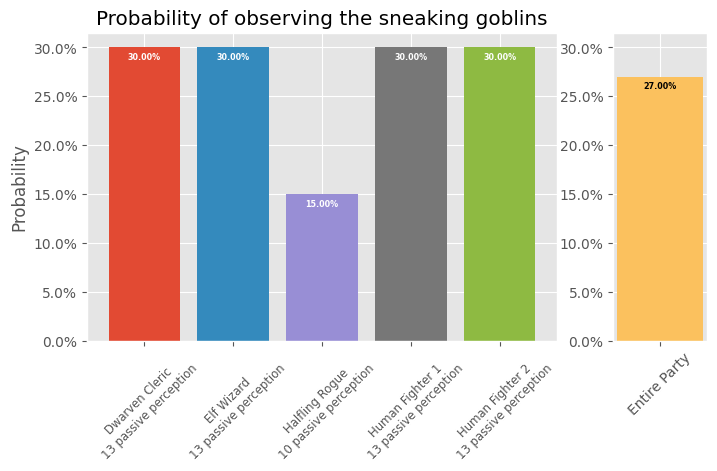
Initiative Rolls
Initiative, for everyone involved in this encounter, uses a single die with a flat probability plot (boring). However, I think the comparison between characters is interesting:
# d20 is defined above initiative = [ # Character, Initiative ("Dwarven Cleric\n-1 initiative", -1), ("Elf Wizard\n+2 initiative", 2), ("Halfling Rogue\n+3 initiative", 3), ("Human Fighter1\n-1 initiative", -1), ("Human Fighter2\n+3 initiative", 3), ("Goblins\n+2 initiative", 2), ] initiative_arrays = [] for _, modifier in initiative: initiative_arrays.append(d20 + modifier) # Initialize plot fig, ax = plot.subplots() fig.set_size_inches(6, 6) for i, array in enumerate(initiative_arrays): x = i + 1 left = array[0] right = array[-1] - array[0] average = array.mean() # Create horizontal bar plot for initative roll range for each creature ax.barh(x, right, height=0.5, left=left) # Create average initative roll annotation for each creature ax.vlines(average, x - 0.35, x + 0.35, color=f"C{i}", linewidth=4.0) ax.vlines(average, x - 0.3, x + 0.3, color="white") ax.annotate( f"{average} average", (average + 0.5, x), backgroundcolor="white", color=f"C{i}", fontsize="x-small", fontweight="bold", horizontalalignment="left", verticalalignment="bottom", ) # Configure Title ax.set_title("Initiative roll ranges") # Confgure X Axis ax.set_xlabel("Roll Result\n(d20 + modifier)") ax.xaxis.set_minor_locator(ticker.AutoMinorLocator()) ax.set_xlim(-2, 26) # Configure Y Axis ax.yaxis.set_major_locator( ticker.FixedLocator(range(len(initiative_arrays) + 1)) ) ax.yaxis.set_major_formatter( ticker.FixedFormatter([""] + [item[0] for item in initiative]) )
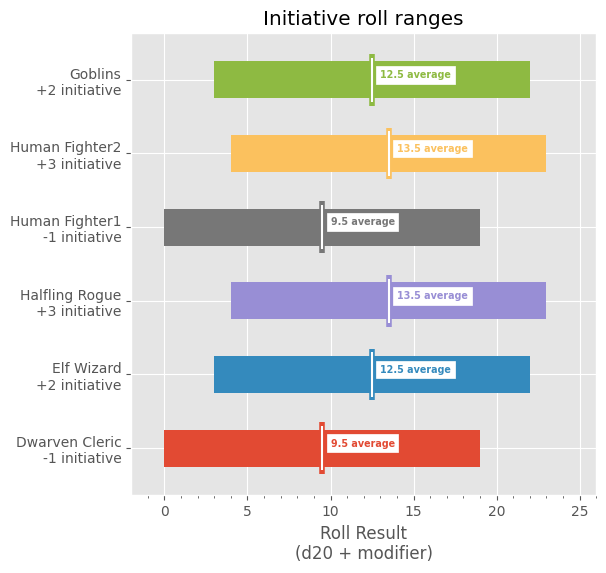
Damage Rolls
With initiative order established, let us investigate the more interesting damage probabilities. We'll only explore the specific damage rolls with interesting (not flat) plots. Last we'll compare damage ranges and averages.
Hafling Rogue
The Halfling Rogue can do sneak attack damage when a fellow party member is adjacentto their target:
# annotate() and d6 are defined above # Create datasets proficiency_modifier = 1 dexterity_modifier = 2 modifier = proficiency_modifier + dexterity_modifier d6_plus_mod = d6 + modifier counts = [] for combination in product(d6_plus_mod, d6): counts.append(sum(combination)) counts.sort() average_damage = int(numpy.array(counts).mean()) results = numpy.array(sorted(list(set(counts)))) # Initialize plot fig, ax = plot.subplots() fig.set_size_inches(6, 4) # Create bar plot for each damage roll result probability probability_total = 0 for result in results: damage_probability = (counts.count(result) / len(d6_plus_mod) ** 2) * 100 probability_total += damage_probability ax.bar(result, damage_probability, color="maroon", width=0.9) annotate(ax, result, damage_probability) # Create average damage annotation ax.annotate( f"{average_damage:.0f} average damage", (average_damage, 1), backgroundcolor="white", color="maroon", fontsize="small", fontweight="bold", horizontalalignment="center", rotation="vertical", verticalalignment="bottom", ) # Configure Title ax.set_title("Halfling Rogue damage probability\nShortbow + Sneak Attack") # Confgure X Axis ax.set_xlabel("Damage\n(1d6 + 3) + 1d6") ax.xaxis.set_major_locator(ticker.FixedLocator(results)) # Confgure Y Axis ax.set_ylabel("Probability") ax.yaxis.set_major_formatter(ticker.PercentFormatter(decimals=0)) # check probability for errors if probability_total > 100.001: print("ERROR: total damage probability:", probability_total)
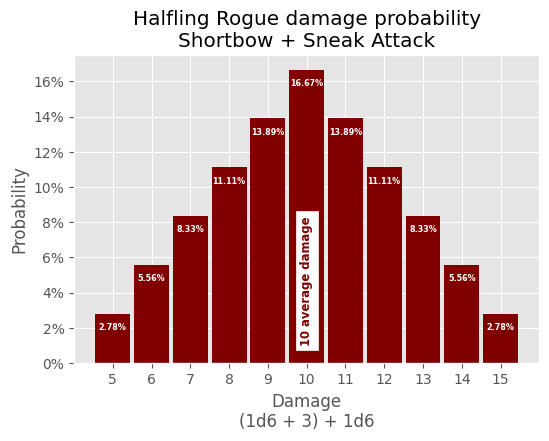
Elf Wizard
The Elf Wizard has more interesting attacks in terms of probability. First, we'll investigate the damage probability of the Magic Missile spell at 1st level:
# annotate() and d4 are defined above # Create datasets d4_plus_mod = d4 + 1 counts = [] for combination in product(d4_plus_mod, d4_plus_mod, d4_plus_mod): counts.append(sum(combination)) counts.sort() average_damage = numpy.array(counts).mean() results = numpy.array(sorted(list(set(counts)))) # Initialize plot fig, ax = plot.subplots() fig.set_size_inches(6, 4) # Create bar plot for each damage roll result probability probability_total = 0 for result in results: damage_probability = (counts.count(result) / len(d4_plus_mod) ** 3) * 100 probability_total += damage_probability ax.bar(result, damage_probability, color="maroon", width=0.9) annotate(ax, result, damage_probability) # Create average damage annotation ax.annotate( f"{average_damage:.1f} average damage", (average_damage, 1), backgroundcolor="white", color="maroon", fontsize="small", fontweight="bold", horizontalalignment="center", rotation="vertical", verticalalignment="bottom", ) # Configure Title ax.set_title( "Elf Wizard damage probability\nMagic Missile at 1st level against a" " single target" ) # Confgure X Axis ax.set_xlabel("Damage\n(1d4 + 1) + (1d4 + 1) + (1d4 + 1)") ax.xaxis.set_major_locator(ticker.FixedLocator(results)) # Confgure Y Axis ax.set_ylabel("Probability") ax.yaxis.set_major_formatter(ticker.PercentFormatter(decimals=0)) # check probability for errors if probability_total > 100.001: print("ERROR: total damage probability:", probability_total)
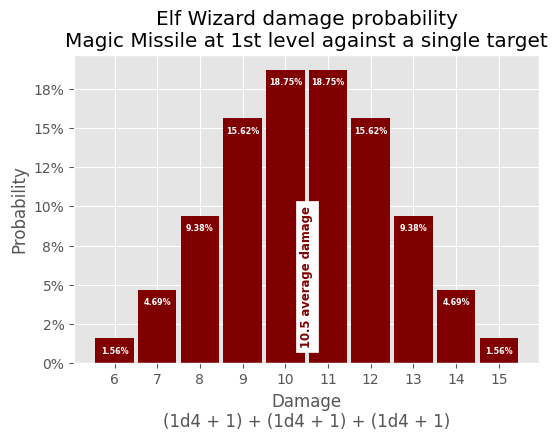
Next, we'll investigate the damage probability if the Elf Wizard casts the Burning Hands spell at 1st level:
# annotate() and d6 are defined above # Create datasets counts = [] for combination in product(d6, d6, d6): counts.append(sum(combination)) counts.sort() average_damage = numpy.array(counts).mean() results = numpy.array(sorted(list(set(counts)))) # Initialize plot fig, ax = plot.subplots() fig.set_size_inches(10, 4) # Create bar plot for each damage roll result probability probability_total = 0 for result in results: damage_probability = (counts.count(result) / len(d6) ** 3) * 100 probability_total += damage_probability ax.bar( result, damage_probability + 1, bottom=-1, color="maroon", width=0.9 ) annotate(ax, result, damage_probability) # Create average damage annotation ax.annotate( f"{average_damage:.1f} average damage", (average_damage, 0), backgroundcolor="white", color="maroon", fontsize="small", fontweight="bold", horizontalalignment="center", rotation="vertical", verticalalignment="bottom", ) # Confgure Title ax.set_title("Elf Wizard damage probability\nBurning Hands at 1st level") # Confgure X Axis ax.set_xlabel("Damage\n3d6") ax.xaxis.set_major_locator(ticker.FixedLocator(results)) # Confgure Y Axis ax.set_ylabel("Probability") ax.yaxis.set_major_formatter(ticker.PercentFormatter(decimals=0)) # check probability for errors if probability_total > 100.001: print("ERROR: total damage probability:", probability_total)

Goblins
The total damage of the four goblins:
# annotate() and d6 are defined above # Create datasets dexterity_modifier = 2 d6_plus_mod = d6 + dexterity_modifier counts = [] for combination in product(d6_plus_mod, d6_plus_mod, d6_plus_mod, d6_plus_mod): counts.append(sum(combination)) counts.sort() average_damage = int(numpy.array(counts).mean()) results = numpy.array(sorted(list(set(counts)))) # Initialize plot fig, ax = plot.subplots() fig.set_size_inches(12, 4) # Create bar plot for each damage roll result probability probability_total = 0 for result in results: damage_probability = (counts.count(result) / len(d6_plus_mod) ** 4) * 100 probability_total += damage_probability ax.bar( result, damage_probability + 1, bottom=-1, color="maroon", width=0.9 ) annotate(ax, result, damage_probability) # Create average damage annotation ax.annotate( f"{average_damage:.0f} average damage", (average_damage, 0), backgroundcolor="white", color="maroon", fontsize="small", fontweight="bold", horizontalalignment="center", rotation="vertical", verticalalignment="bottom", ) # Confgure Title ax.set_title("Four Goblins\nScimitars or Shortbows") # Confgure X Axis ax.set_xlabel("Damage\n(1d6 + 2) + (1d6 + 2) + (1d6 + 2) + (1d6 + 2)") ax.xaxis.set_major_locator(ticker.FixedLocator(results)) # Confgure Y Axis ax.set_ylabel("Probability") ax.yaxis.set_major_formatter(ticker.PercentFormatter(decimals=0)) # check probability for errors if probability_total > 100.001: print("ERROR: total damage probability:", probability_total)
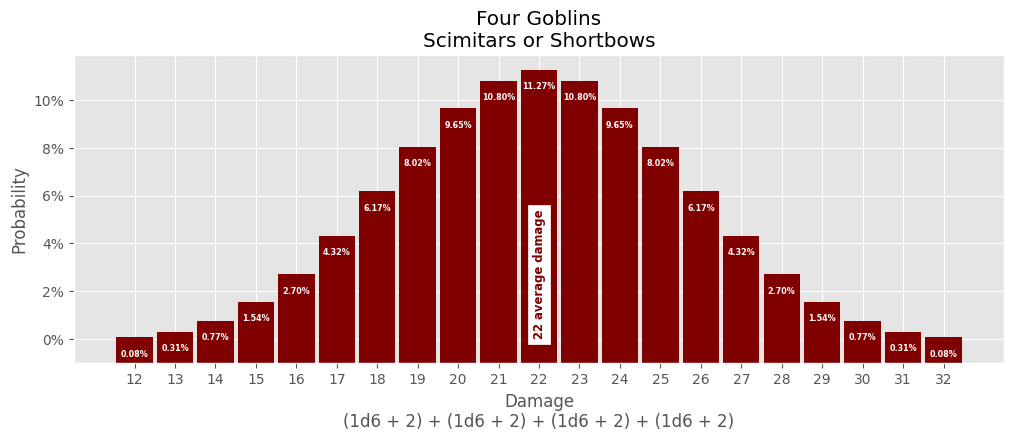
Damage Range Comparisons
Last, let's look at optimal damage comparisons (ignoring criticals, but otherwise assuming the best circumstance for each character or monster group):
# dice() is defined above # Create dataset: character, damage array damage = [ ("Dwarven Cleric\nWarhammer\n1d8 + 2", dice("1d8 + 2")), ("Elf Wizard\nBurning Hands\n3d6", dice("3d6")), ( "Halfling Rogue\nShortbow & Sneak Attack\n(1d6 + 3) + 1d6", dice("2d6 + 3"), ), ("Human Fighter 1\nGreataxe\n1d12 + 3", dice("1d12 + 3")), ("Human Fighter 2\nLongbow\n1d8 + 3", dice("1d8 + 3")), ("Goblins\nScimatar / Shortbow\n1d6 + 2", dice("1d6 + 2")), ] # Initialize plot fig, ax = plot.subplots() fig.set_size_inches(6, 6) for i, (_, array) in enumerate(damage): x = i + 1 left = array[0] right = array[-1] - array[0] average = array.mean() ax.barh(x, right, height=0.5, left=left, label="x") ax.vlines(average, x - 0.35, x + 0.35, color=f"C{i}", linewidth=4.0) ax.vlines(average, x - 0.3, x + 0.3, color="white") ax.annotate( f"{average} average", (average + 0.3, x), backgroundcolor="white", color=f"C{i}", fontsize="x-small", fontweight="bold", horizontalalignment="left", verticalalignment="bottom", ) # Confgure Title ax.set_title("Individual damage ranges") # Confgure X Axis ax.set_xlabel("Damage") ax.xaxis.set_major_locator(ticker.MaxNLocator(steps=(2, 10))) ax.set_xlim(2, 20) # Confgure Y Axis ax.yaxis.set_major_locator( ticker.FixedLocator(range(len(initiative_arrays) + 1)) ) ax.yaxis.set_major_formatter( ticker.FixedFormatter([""] + [item[0] for item in damage]) ) ax.yaxis.set_tick_params(labelsize="small")
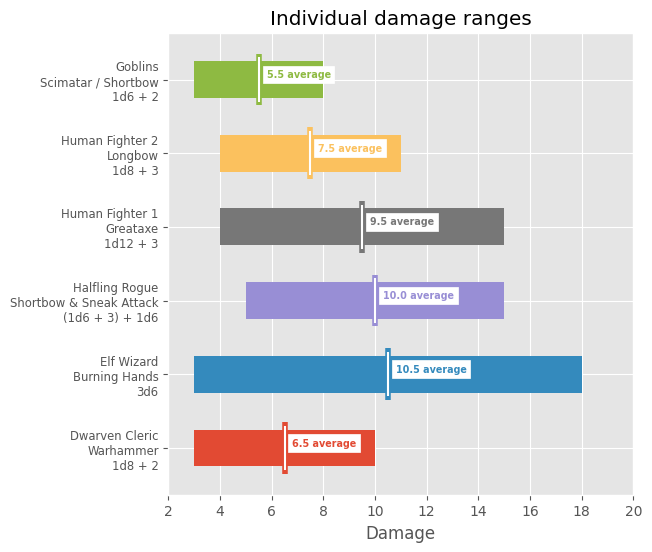
The players have the benefit of outnumbering the goblins:
# Create dataset: group, damage array damage = [ ("Players", numpy.arange(19, 74)), ("Goblins", numpy.arange(12, 33)), ] # Initialize plot fig, ax = plot.subplots() fig.set_size_inches(6, 2) for i, (_, array) in enumerate(damage): left = array[0] right = array[-1] - array[0] average = int(array.mean()) x = i + 1 ax.barh(x, right, height=0.5, left=left) ax.vlines(average, x - 0.35, x + 0.35, color=f"C{i}", linewidth=4.0) ax.vlines(average, x - 0.3, x + 0.3, color="white") ax.annotate( f"{average} average", (average + 1, x), backgroundcolor="white", color=f"C{i}", fontsize="x-small", fontweight="bold", horizontalalignment="left", verticalalignment="bottom", ) # Confgure Title ax.set_title("Combined damage ranges") # Confgure X Axis ax.set_xlabel("Damage") ax.xaxis.set_major_locator(ticker.MaxNLocator(nbins=17, steps=(5, 10))) ax.xaxis.set_minor_locator(ticker.AutoMinorLocator()) ax.set_xlim(10, 76) # Confgure Y Axis ax.yaxis.set_major_locator( ticker.FixedLocator(range(len(initiative_arrays) + 1)) ) ax.yaxis.set_major_formatter( ticker.FixedFormatter([""] + [item[0] for item in damage]) )

Notes and References
- D&D Content
- Lost Mine of Phandelver D&D adventure (free, but requires D&D Beyond signup)
- D&D Rules
- D&D and Probability
- [5e] The math and probability behind rolling with advantage! : DnD
- D&D Probability distributions (tabular data is inaccurate--off by 1)
- I made a probability calculator for DnD dice rolls! : DungeonsAndDragons
- Comment - DnD has led me to discover a rule of probability and I feel like Blaise Pascal : DnD (more complex problems may require simulation instead of maths)
- JupyterLab
- Jupyter Project Documentation
- ryantam626/jupyterlab_code_formatter (note that the extension is configured in Jupyter Lab, not config files)
- Matplotlib
- NumPy
- Python Documentation
Trademark Notice
Dungeons & Dragons, D&D, their respective logos, and all Wizards titles and characters are property of Wizards of the Coast LLC in the U.S.A. and other countries. All other trademarks referenced are the property of their respective owners.
Source
 Dedicated, with all copyright and related and neighboring rights, to the public domain worldwide. It is distributed without any warranty (CC0 1.0 Universal (CC0 1.0) Public Domain Dedication).
Dedicated, with all copyright and related and neighboring rights, to the public domain worldwide. It is distributed without any warranty (CC0 1.0 Universal (CC0 1.0) Public Domain Dedication).